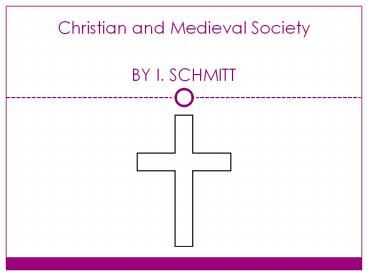Later Middle Ages - PowerPoint PPT Presentation
Title:
Later Middle Ages
Description:
Later Middle Ages by Isabel Schmitt – PowerPoint PPT presentation
Number of Views:155
Title: Later Middle Ages
1
Christian and Medieval Society
- BY I. SCHMITT
2
The church shaped politics and society
- The clergy were very influential in medieval
European culture and politics (clergy) - For many people in the middle ages, life revolved
around the local church (society) - Some people made pilgrimages, journeys to
religious locations (also known as pilgrims) - Church officials often became political advisors
to local rulers (politics)
3
The Monks of Cluny
- The monks of Cluny, France, established a new
religious order - They dedicated their lives to religion with
common rules - Monks lived apart from society, but two new
religious orders developed for those who wanted
to live and teach among people
4
Friars
- The difference between monks and friars are that
monks lived away from society and thought it was
better to get away from sin, while the friars
tried to help the sinners - Friars thought that they could reach out to
sinners and help them - Friars were members of Franciscans, which was
created by Francis of Assisi
5
Universities are built
- Europe's first universities were created by
church - Religion, law, medicine, and philosophy were
taught - The students were tested now and then
- The Dominican friar Thomas Aquinas wrote a
reasoned argument for the existence of god and
developed a philosophical system called Natural
Law
6
Religious architecture/art
- Religious architecture was inspired by religious
expression - The great gothic cathedral of late medieval
Europe are among the most beautiful of all
architectural achievements - Everything inside the church was also art
7
Summary
- In summary, church, religion, and religious
officials were some of the most important things
in medieval Europe.
8
The Magna Carta
-The Magna Carta took away some of the king's
power because they were becoming too powerful.
-It gave others more rights so everyone had a
fair life and got rights they deserved. -The
Magna Carta was an important document that listed
rights that the king could not ignore. -Its name
is a Latin phrase meaning Great Charter.
9
Who demanded this agreement?
In 1215 a group of nobles decided to force the
king to respect their rights, so they drew up the
Magna Carta.
10
Magna Carta effects
The nobles drew up a list of demands for the king
called the Magna Carta. The Magna Carta required
the king to honor certain rights. Three of these
rights -Right of Habeas-nobody in jail without a
reason. -Justice will be given without delays or
bribes. -The king must not interfere with the
church.
11
What did the M/C inspire the nobles to do?
-The nobles formed a council to advise the king
. -This council later turned into parliament.
-Parliament is still used in England today. -The
king agreed to free the courts from his control
12
My own Magna Carta?
- No bullying what so ever
- Chances to get extra credit if you need/want it
- The teacher cant call out a student just to
embarrass them
13
The 100 year war
14
What was it?
The Hundred Years' War was a series of
conflicts waged from 1337 to 1453 between the
England and France for control of the French
throne.
15
The coarse of the war
- In 1328 the king of France died with no heirs.
- The English king and a French man tried to claim
the throne. - The french man won.
- Joan of Arc was the girl who said God told her to
lead England out of France forever.
16
Results of the war
- The black death
- Frances population decreases dramtically
- England lost its continental land holdings
- Democracy in France has to wait
17
The Black Death
- (The plague)
18
The black death
- It originated in Asia but came to Europe and
lasted from 1348-1350 - The fleas on rats had carried the disease
- It was called the bubonic plague
- It killed (about) 25 million people
- The victim of this disease would usually only
last 2-4 days after being in contact with it - They tried to treat it with herbs and other
remedies
19
SOURCES!!!!
- MR. FRAZIER
- WIKIPEDIA
- THE PACKET
- A TEXT BOOK































